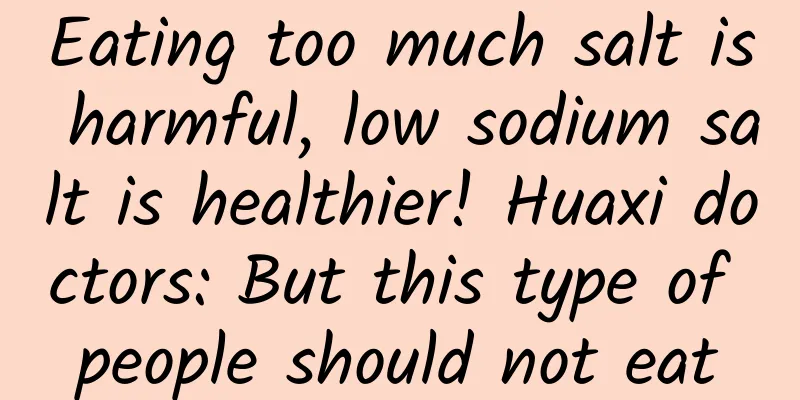Can instant noodles really have a 12-month shelf life? How can we prevent free radicals like viruses?

|
Recently, the media interviewed the following questions: How do some imported instant noodles have a shelf life of up to 12 months? Why are domestic preservative-free instant noodles marked with a shelf life of 6 months? Similarly, the shelf life of domestic boxed pure milk is 6 months, while that of imported milk is 12 months. Why is it so long? There are also many foods that have a shelf life of at least 12 months. Are these things worth buying? In fact, what’s wrong with having a longer shelf life for food? The shipping time is sufficient, the sales range is large, and the manufacturers are happy; the sales risk is small, and the merchants are happy; it is safe to store at home, and consumers are also happy. Especially during the epidemic, who wants to stock up on food at home? However, when it comes to food that doesn't spoil in a year or two, some people always worry: Can it really be stored that long? Why doesn't it spoil? People worry about the shelf life of food because they are actually worried that the food will go bad before its expiration date or that its edible quality will deteriorate. There are two most common reasons for food spoilage: one is spoilage caused by microbial activity, and the other is spoilage caused by chemical reactions such as fat oxidation. Let’s first talk about the deterioration caused by microorganisms. After the microorganisms multiply, there may be three kinds of trouble: First, it will produce various enzymes, which will change the smell and taste of food and make it lose its edible value. This is the result of daily food becoming rancid, sour and smelly after being left for a long time. Second, some pathogenic microorganisms proliferate, which may cause bacterial or viral food poisoning. For example, if someone eats food that does not seem to have a noticeable taste but suffers from loss of appetite, vomiting, diarrhea, abdominal bloating or cramps, or even weakness and fever, it is likely that this type of food poisoning has occurred. Third, the activities of pathogenic microorganisms produce various toxins, which may cause acute or chronic poisoning. For example, "eating sour soup caused the whole family to be wiped out", "eating soaked black fungus and entering the ICU", "eating leftover noodles and entering the ICU", "living in danger after eating homemade black beans" and other incidents are mostly caused by toxins produced by microorganisms. The simplest way to control microorganisms is to deprive them of the water they need for activity, either by making the food very dry or by adding a lot of sugar or salt to the food so that the salt and sugar take away the water they need for activity. Of course, there are other methods, such as adding a lot of alcohol or preservatives to food to help inhibit the activity of microorganisms; or putting food in the freezer to allow low temperatures to inhibit the proliferation of microorganisms. Instant noodles are very dry, so microorganisms cannot multiply in large numbers. Therefore, as long as the instant noodles are not damp, there is no need to worry about food safety issues caused by microorganisms. But why do instant noodles need to be labeled with a shelf life? Since microorganisms cannot reproduce, they can be preserved forever. Why do they need to be labeled with a 6-month shelf life? This is because there is a second reason for food spoilage, which is some chemical reactions that are not conducive to food quality, such as the most common fat oxidation reaction. Here we will focus on fat oxidation reaction. As long as natural fat is placed in the presence of oxygen, it will automatically undergo oxidation. It is called "auto-oxidation" for its true meaning. Auto-oxidation reactions are initiated by free radicals. Due to the effects of light, heat, radiation, singlet oxygen, metal catalysts, etc., a very small number of unsaturated fatty acid molecules become restless, they lose hydrogen atoms and become free radicals. These free radicals are like the new coronavirus. Although the amount is small, they are highly contagious and can cause healthy fatty acids to be "infected" and also become free radicals. Then, they slowly begin to "spread in the community" until a large area of fatty acids are infected. Once a spark has spread, it can become a prairie fire, as we have seen in South Korea and Hong Kong. Fatty acids attacked by free radicals absorb oxygen atoms and become "hydroperoxides". When they accumulate to a certain level, they will decompose and produce some small molecules with unpleasant odors. Then we feel that the food has "changed its taste". The so-called "rancid smell", "oil smell", "wormwood smell", "old oil smell", etc., are all the smells produced by fat oxidation. When this smell is noticeable, the food is unfit for consumption. Oxidatively spoiled food not only tastes bad, but also contains many substances that easily generate free radicals, as well as toxic and harmful oxidative decomposition products. At the same time, most of the vitamin E and essential fatty acids that are useful to the human body will also be lost. Once eaten, they can also promote disease and aging. It can be said that after oxidation and deterioration, food loses its health value. Unless you are extremely hungry and need a little calories to survive, never eat these spoiled foods. Be it instant noodles, cookies, potato chips, rice crusts, fried foods, peanuts, melon seeds and nuts, cooking oil and sesame paste...as long as it is food containing oil, it is likely to be attacked by the "virus" of fat auto-oxidation, and then deteriorate and change in taste. Unfortunately, fat auto-oxidation is a difficult problem to completely solve. Neither drying nor freezing can completely stop it, but it can only slow down its progress. If you want to preserve it for a longer time, you have to think of various ways to slow down the auto-oxidation process of fat. How to extend the shelf life of oily foods? On the one hand, it is to choose fat raw materials that are not easy to oxidize. Generally speaking, saturated fatty acids are not so easy to oxidize, and the higher the degree of unsaturation, the easier it is to oxidize. For example, linseed oil is highly unsaturated, so it is very easy to oxidize, especially when heated. This is why it is not recommended for sautéing or stir-frying. In comparison, coconut oil, palm oil, cocoa butter, etc. are highly saturated and are not so easy to oxidize. Therefore, many fried foods such as fried instant noodles, rice crust potato chips, etc. like to be made with palm oil, because it is cheap, stable, and has a crispier texture after fried. On the other hand, it is also necessary to prevent fatty acids from being easily exposed to oxygen, after all, oxidation will occur only with oxygen. Therefore, efforts should be made in packaging, airtight packaging, vacuuming or nitrogen filling, and adding a pack of "deoxidizer" to create a relatively "safe" environment for fat-containing foods. In addition, we must find a way to remove the metal ions that can catalyze the oxidation reaction. During storage, it is necessary to reduce the influence of light, radiation and temperature, as these will promote oxidation. It is wise to store in opaque packaging in a cool environment. Finally, there is another great trick, which is to add "antioxidants". This additive can "extinguish" the small amount of "free radicals" that appear in the early stage in time, preventing a spark from becoming a prairie fire. Therefore, almost all foods with a lot of fat and a long shelf life are added with antioxidants. There is a lot of knowledge involved in what kind of antioxidants to add, how much to add, or how many antioxidants to use in combination. Can the shelf life of instant noodles be extended from 6 months to 12 months? Take the case of imported instant noodles with a 12-month shelf life label. In response to media questions, the manufacturer reportedly said: "Antioxidants have been added to this product." It is true that antioxidants can slow down the process of instant noodles going bad, but they cannot make food indestructible. As long as time is long enough, food will eventually oxidize. Therefore, even if antioxidants are added, instant noodles still need to be labeled with a shelf life. Most products are labeled with a shelf life of 6 months, and storage and sales practices have proven that this shelf life is fine. Therefore, 6 months has become an industry practice. Generally speaking, when developing a product, various experiments are conducted to determine its quality standards and shelf life under specified conditions. Whether a product that is usually labeled with a shelf life of 6 months can be labeled with a shelf life of 12 months requires a shelf life experiment. For example, if the shelf life of imported packaged milk is to be extended from 6 months to 12 months, the sterilization temperature and time will need to be adjusted. If instant noodles are to double their shelf life, they may also need to make some adjustments to the types, amounts and packaging of antioxidants to ensure that all indicators are up to standard after 12 months and that there is no perceptible change in flavor. It is best to present the data to reassure consumers. If you keep the raw materials, formula, packaging and storage conditions unchanged, and have not conducted any shelf life tests, and simply add 6 months to the shelf life and sell it, this is not very reliable. Should you buy foods with a longer shelf life? This question should be decided by consumers based on cost-effectiveness and personal needs. For example, for boxed milk, a longer shelf life can ensure that it is shipped across the oceans and sold in various places with greater peace of mind, but more powerful sterilization treatments will also lead to a decrease in vitamin content and flavor quality. Proteins may generate a small amount of "isopeptide bonds", reducing bioavailability; lysine content will decrease due to mild Maillard reactions, and sulfur-containing amino acids may be partially lost due to heat. Therefore, for those who care about the flavor and taste of milk, or the nutritional quality of milk, it is better to buy fresh refrigerated pasteurized milk. But if you just want to use milk for cooking, for making drinks, or just want to add some calcium and protein, don't care about vitamins, and are more concerned about cost-effectiveness, then buying boxed milk is still very cost-effective. There are many types of instant noodles to choose from, so consumers can choose according to their own preferences. If you don't need to keep the instant noodles for a long time, and eat them within ten days, a half month, or one or two months, then you don't have to deliberately choose products with a shelf life of one year. If you just want to stock up for emergencies, a longer shelf life may be more convenient. I am quite pleased that consumers have become more and more adept at reading product labels and are increasingly aware of questioning product-related information. This shows that consumers have become more sophisticated, which is a good thing. Reprint/ Cooperation please contact Weibo/ Official Account: Fan Zhihong_Original Nutrition Information |
<<: Strong carcinogenicity! Don't eat this kind of fruit
>>: No one knows more about corpses than I do! Not for the faint of heart!
Recommend
Activity Operation: How to design activity prizes that stimulate user desire?
All methods of gaining traffic are designed as ba...
Top 10 Core Data tools and open source libraries loved by developers
Core Data is a great choice for storing and query...
The dilemma faced by new energy logistics vehicle operators: small profit margins are the core issue
New energy vehicles are supported by governments ...
Why do flying insects like to chase light? The answer to a question that has puzzled scientists for a long time has been found!
Li Zhaoying At night, we often observe an interes...
Creative inventory of 7 major mainstream industries, all cases of information flow CTR8% are here!
I guess many optimizers have suffered from creati...
Top 10 Marketing Observations in 2020: Integration of Advertising and Private Domain Traffic
A sudden epidemic in 2020 not only affected every...
Understanding neuromorphic computing: from basic principles to experimental verification
The human brain has long been an inspiration to r...
Can we eat the green onion?
Every summer, it is the season for eating mushroo...
The black box has been found! All aircraft are required to install it. What important information can it provide?
The crash of China Eastern Airlines flight MU5735...
Dan Nystedt: Nvidia will contribute 11% of TSMC's revenue in 2023
According to financial expert Dan Nystedt's f...
Who plays Xiao He Ziqiu in In the Name of Family? Personal information of Xiao Lizhen, the actor who played He Ziqiu as a child
The TV series "In the Name of Family" i...
A single advertisement was exposed over 150,000 times, and the promotion was explosively promoted in the circle of friends of overseas study agencies!
Invisible poor parents, tutoring phobia, cram sch...
How to create the Shaoguan food ordering mini program? How much does it cost to develop a food ordering app?
The catering industry has become the first choice...
Understanding the pre-reorganization of WM Motor, which is undergoing a rebirth and transformation
Although the new energy vehicle market is booming...
How to place ads on Kuaishou? HOW DOES IT PERFORM?
Kuaishou is one of the few short video communitie...









